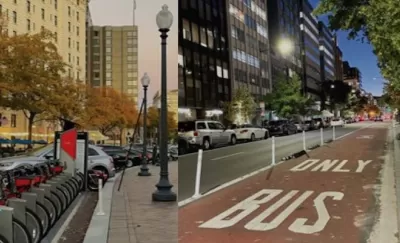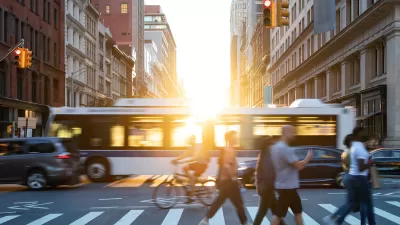Motor vehicle travel benefits users but also imposes large economic, social, and environmental costs. With better planning, our needs can be met with less vehicle travel. A new ITE report describes why and how to optimize the amount we drive.

Motor vehicle travel provides many benefits, but also imposes large economic, social and economic costs. A new Institute of Transportation Engineers report, Vehicle-Miles Traveled (VMT) as a Metric for Sustainability, can help guide planning to optimize the amount people drive.
This is an important and timely issue. Per capita vehicle-miles traveled (VMT) grew steadily during the Twentieth Century. During the growth period, transportation agencies applied “predict and provide” planning practices that contributed to a self-reinforcing cycle of expanded roads, more parking subsidies, reduced non-auto travel options, and sprawled development patterns that created automobile-dependent communities where it is difficult to get around without a car.
Per capita motor vehicle travel peaked about 2005, and current demographic and economic trends (aging population, rising vehicle costs, changing consumer preferences, increased health and environmental concerns) are increasing non-auto travel demands. In response, many transportation agencies are shifting from mobility-oriented planning, which assumed that our goal is to maximize travel speed and distance, to accessibility-oriented planning, which recognizes the ultimate goal of transportation is to provide access to services and activities, and policies intended to increase mobility often reduce accessibility in other ways.
To achieve sustainability goals, many jurisdictions are now reforming their planning practices to support accessibility-based planning. Some have established vehicle travel reduction targets to help guide these reforms. These policies can be justified for several reasons: to support more multimodal planning, to reduce traffic congestion, to reduce road and parking infrastructure costs, to reduce pollution emissions, and to improve community livability, public fitness and health.
This report discusses how much vehicle travel can be reduced, appropriate analysis methods and planning practices, and effective VMT reduction strategies. It also includes case studies from locations that optimized vehicle travel in the United States and internationally.
FULL STORY: VMT as a Metric for Sustainability

Alabama: Trump Terminates Settlements for Black Communities Harmed By Raw Sewage
Trump deemed the landmark civil rights agreement “illegal DEI and environmental justice policy.”

Planetizen Federal Action Tracker
A weekly monitor of how Trump’s orders and actions are impacting planners and planning in America.

The 120 Year Old Tiny Home Villages That Sheltered San Francisco’s Earthquake Refugees
More than a century ago, San Francisco mobilized to house thousands of residents displaced by the 1906 earthquake. Could their strategy offer a model for the present?

In Both Crashes and Crime, Public Transportation is Far Safer than Driving
Contrary to popular assumptions, public transportation has far lower crash and crime rates than automobile travel. For safer communities, improve and encourage transit travel.

Report: Zoning Reforms Should Complement Nashville’s Ambitious Transit Plan
Without reform, restrictive zoning codes will limit the impact of the city’s planned transit expansion and could exclude some of the residents who depend on transit the most.

Judge Orders Release of Frozen IRA, IIJA Funding
The decision is a victory for environmental groups who charged that freezing funds for critical infrastructure and disaster response programs caused “real and irreparable harm” to communities.
Urban Design for Planners 1: Software Tools
This six-course series explores essential urban design concepts using open source software and equips planners with the tools they need to participate fully in the urban design process.
Planning for Universal Design
Learn the tools for implementing Universal Design in planning regulations.
Clanton & Associates, Inc.
Jessamine County Fiscal Court
Institute for Housing and Urban Development Studies (IHS)
City of Grandview
Harvard GSD Executive Education
Toledo-Lucas County Plan Commissions
Salt Lake City
NYU Wagner Graduate School of Public Service





























